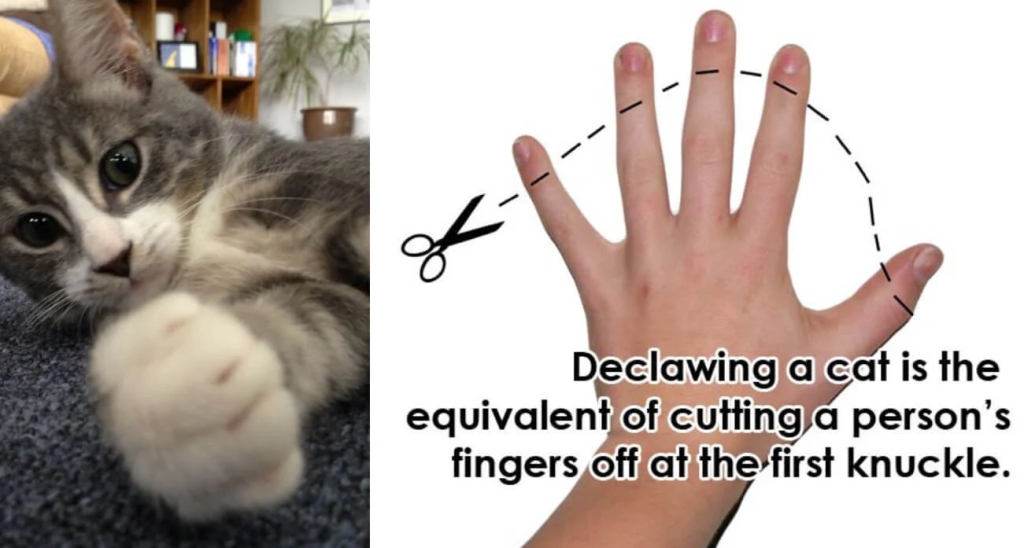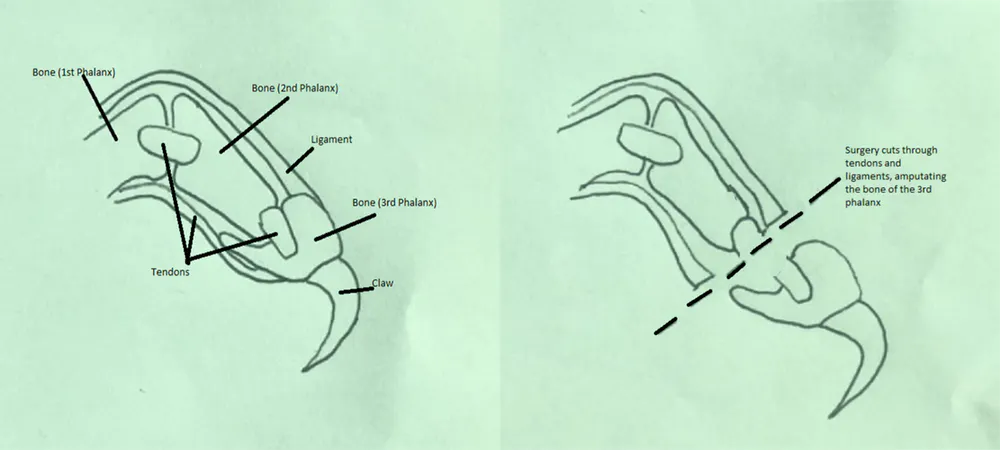
One of the ways I learned more about declawing cats is by watching a documentary called The Paw Project. Available on YouTube. It was recorded in 2015.
The Paw Project was founded by Dr. Jennifer Conrad, a California Veterinarian and an advocate for banning feline declawing. She led the effort in West Hollywood, CA to ban declawing in 2003 and continued her crusade in other California cities. At the time of this writing Los Angeles, San Francisco, Santa Monica, Beverly Hills, Berkeley, Culver City, and Burbank have also banned declawing.
New York and Maryland have already banned declawing.
Countries around the world that have banned declawing include England, Scotland, Wales, Italy, France, Germany, Austria, Switzerland, Norway, Sweden, Netherlands, Northern Ireland, Ireland, Denmark, Finland, Slovenia, Portugal, Belgium, Spain, Brazil, Australia and New Zealand. Many of these countries classify declawing as mutilation. And that is exactly what it is.
Here is a link to the Paw Project website.
The ASPCA and the Humane Society have both spoken out against declawing cats.
ASPCA Statement on Declawing Cat’s
Humane Society on Declawing Cat’s
Many people do not understand exactly what declawing involves. The cats toes are amputated from the last joint down. This is akin to cutting off a human’s fingers from the knuckle joint down. And the toes from the Proximal interphalangeal joint down. It is a horrific procedure.

Declawing Facts
Declawing offers no benefit to cats.
The procedure amputates the cat’s toes up to the first joint.

Immediately following surgery, the cat can have an adverse reaction to the anesthetic which can include death. If the adhesive bandages are wrapped improperly or to tightly the paw may become gangrenous which can require amputation of the leg. When the bandages are removed bleeding can be profuse and ongoing requiring rebandaging and a longer stay at the clinic.
Most cats experience lifelong pain and suffering after declawing. This can include paw pain and nerve damage, regrowth of improperly removed claws, bone spurs and arthritis and crippling. Many cats become lame or develop an abnormal gait. Cats walk on their toes and if they are unable to walk normally, they can develop stiffness and pain in their hips, back, spine and legs.
Most cats experience behavioral changes after they are declawed. This can be due to pain, anxiety and the inability to scratch to relive stress and maintain their nails. Since scratching is an instinctive behavior not having the ability to do so causes the cat to suffer.
They may refuse to use the litterbox due to pain.
If a cat suffers from behavioral problems due to declawing, they are often euthanized.
Veterinarian’s use different methods to perform the declawing procedure. These include using a scalpel or guillotine clippers, lasers to slice through the tissue and tendonectomies which severs the tendon that controls the claw in each toe. The result is that cats can’t extend their claws to scratch. These cats will require frequent nail trimming as they cannot use a scratching post after the procedure.
One study found that 42% of declawed cats had ongoing long-term pain and about 25% of declawed cats limp.
A cat can no longer go outdoors after they have been declawed. They use their claws for climbing and defending themselves.
Why Cat’s Scratch
Scratching is a natural behavior for cats. They do it to maintain their claws, leave their scent and mark their territory, relieve stress and anxiety, scratch their bodies and express their emotions. Know this before adopting a cat. They will use their claws and if you cannot live with that, don’t get a cat.
Instead of Declawing
Plastic nail caps can be used to prevent a cat from scratching and damaging furniture. Like these on Jackson Galaxy’s website. Cat Nail Caps or these from Soft Paws. Softpaws Nail Caps for Cat’s
Provide the cat with plenty of scratching areas. Place them in multiple locations throughout your home. Watch your cat and determine what types of materials they like to use and then provide them with those types of surfaces. When your cat uses the appropriate scratching areas offer them praise, petting and treats to encourage the behavior.
Discourage use of inappropriate surfaces by attaching double sided sticky tape or aluminum foil.
Talk to your veterinarian. They can offer solutions such as ways to reduce feline anxiety and stress that can lead to behavior problems. These can include pheromone diffusers and medication in extreme cases.
Cats scratch to groom their nails. Trim your cats’ nails regularly.
Limit your cats access to rooms that contain expensive furniture to prevent damage.
How Can You Help?
Contact your state representatives and push them to ban cat declawing in your city and state. You can find a list of your state representatives here Find Your State Representatives
Educate others. Explain to people exactly what declawing involves. Share the Paw Project YouTube video with them.
Choose a veterinarian that does not practice or support declawing. You can find a list here.
Veterinarians That Do Not Support Declawing
Write to veterinarians in your area who do declaw and ask them to stop. The Paw Project offers letter writing tips here.
The Humane Society Veterinary Medical Association has a poster that you can download. https://hsvma.memberclicks.net/assets/pdfs/cat_declawing_poster.pdf
Download it and hang it up where you can.
Before adopting a cat be sure you understand all that is involved. Owning any pet is a lifelong commitment and should not be taken lightly. Be prepared to invest in veterinary care, equipment, food, and training. Understand that each cat is different and some have behavioral problems. If you are very fussy about your home and belongings pet ownership may not be for you. They make messes, shed and have accidents. Know all of this before making a commitment. It is not fair to bring a pet home and think of them as disposable.
And please adopt a cat from a shelter or rescue organization. There are so many cats and kittens in need of a loving home.
Have them spayed or neutered to prevent more unwanted cats.